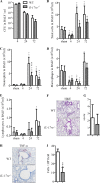Interleukin 17 Receptor E (IL-17RE) and IL-17C Mediate the Recruitment of Neutrophils during Acute Streptococcus pneumoniae Pneumonia
- PMID: 31481409
- PMCID: PMC6803337
- DOI: 10.1128/IAI.00329-19
Interleukin 17 Receptor E (IL-17RE) and IL-17C Mediate the Recruitment of Neutrophils during Acute Streptococcus pneumoniae Pneumonia
Abstract
Neutrophils contribute to lung injury in acute pneumococcal pneumonia. The interleukin 17 receptor E (IL-17RE) is the functional receptor for the epithelial-derived cytokine IL-17C, which is known to mediate innate immune functions. The aim of this study was to investigate the contribution of IL-17RE/IL-17C to pulmonary inflammation in a mouse model of acute Streptococcus pneumoniae pneumonia. Numbers of neutrophils and the expression levels of the cytokine granulocyte colony-stimulating factor (G-CSF) and tumor necrosis factor alpha (TNF-α) were decreased in lungs of IL-17RE-deficient (Il-17re-/- ) mice infected with S. pneumoniae Numbers of alveolar macrophages rapidly declined in both wild-type (WT) and Il-17re-/- mice and recovered 72 h after infection. There were no clear differences in the elimination of bacteria and numbers of blood granulocytes between infected WT and Il-17re-/- mice. The fractions of granulocyte-monocyte progenitors (GMPs) were significantly reduced in infected Il-17re-/- mice. Numbers of neutrophils were significantly reduced in lungs of mice deficient for IL-17C 24 h after infection with S. pneumoniae These data indicate that the IL-17C/IL-17RE axis promotes the recruitment of neutrophils without affecting the recovery of alveolar macrophages in the acute phase of S. pneumoniae lung infection.
Keywords: G-CSF; IL-17; IL-17C; IL-17RE; Streptococcus pneumoniae; host defense; lung infection; neutrophils; pneumonia; sepsis.
Copyright © 2019 American Society for Microbiology.
Figures




Similar articles
-
The IL-17 receptor IL-17RE mediates polyIC-induced exacerbation of experimental allergic asthma.Respir Res. 2020 Jul 8;21(1):176. doi: 10.1186/s12931-020-01434-9. Respir Res. 2020. PMID: 32641167 Free PMC article.
-
IL-17RE is the functional receptor for IL-17C and mediates mucosal immunity to infection with intestinal pathogens.Nat Immunol. 2011 Oct 12;12(12):1151-8. doi: 10.1038/ni.2155. Nat Immunol. 2011. PMID: 21993849
-
IL-17A-mediated expression of epithelial IL-17C promotes inflammation during acute Pseudomonas aeruginosa pneumonia.Am J Physiol Lung Cell Mol Physiol. 2016 Nov 1;311(5):L1015-L1022. doi: 10.1152/ajplung.00158.2016. Epub 2016 Sep 30. Am J Physiol Lung Cell Mol Physiol. 2016. PMID: 27694471
-
IL-17C/IL-17RE: Emergence of a Unique Axis in TH17 Biology.Front Immunol. 2020 Feb 26;11:341. doi: 10.3389/fimmu.2020.00341. eCollection 2020. Front Immunol. 2020. PMID: 32174926 Free PMC article. Review.
-
Neutrophil Recruitment in Pneumococcal Pneumonia.Front Cell Infect Microbiol. 2022 May 13;12:894644. doi: 10.3389/fcimb.2022.894644. eCollection 2022. Front Cell Infect Microbiol. 2022. PMID: 35646729 Free PMC article. Review.
Cited by
-
The IL-17 receptor IL-17RE mediates polyIC-induced exacerbation of experimental allergic asthma.Respir Res. 2020 Jul 8;21(1):176. doi: 10.1186/s12931-020-01434-9. Respir Res. 2020. PMID: 32641167 Free PMC article.
-
Characterization of the Anti-Inflammatory Capacity of IL-10-Producing Neutrophils in Response to Streptococcus pneumoniae Infection.Front Immunol. 2021 Apr 28;12:638917. doi: 10.3389/fimmu.2021.638917. eCollection 2021. Front Immunol. 2021. PMID: 33995357 Free PMC article.
-
IL-17 Cytokines and Chronic Lung Diseases.Cells. 2022 Jul 6;11(14):2132. doi: 10.3390/cells11142132. Cells. 2022. PMID: 35883573 Free PMC article. Review.
-
IL-17C and IL-17RE Promote Wound Closure in a Staphylococcus aureus-Based Murine Wound Infection Model.Microorganisms. 2021 Aug 27;9(9):1821. doi: 10.3390/microorganisms9091821. Microorganisms. 2021. PMID: 34576717 Free PMC article.
-
Contribution of IL-17C-mediated macrophage polarization to Type 17 inflammation in neutrophilic asthma.Cell Commun Signal. 2024 Nov 21;22(1):557. doi: 10.1186/s12964-024-01937-8. Cell Commun Signal. 2024. PMID: 39568050 Free PMC article.
References
-
- Ramirez-Carrozzi V, Sambandam A, Luis E, Lin Z, Jeet S, Lesch J, Hackney J, Kim J, Zhou M, Lai J, Modrusan Z, Sai T, Lee W, Xu M, Caplazi P, Diehl L, de VJ, Balazs M, Gonzalez L Jr, Singh H, Ouyang W, Pappu R. 2011. IL-17C regulates the innate immune function of epithelial cells in an autocrine manner. Nat Immunol 12:1159–1166. doi:10.1038/ni.2156. - DOI - PubMed
MeSH terms
Substances
LinkOut - more resources
Full Text Sources
Molecular Biology Databases

